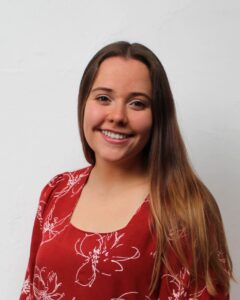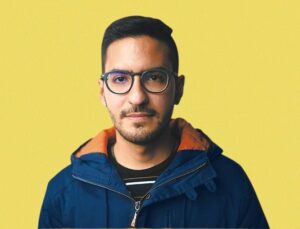Journalists Mariana Escobar Bernoske, gender and diversity reporter at El Espectador; and Felipe Morales Sierra, from the judicial section and La Disidencia at El Espectador, not only cover sexual diversity issues. Both are also part of the LGBTQ+ community and represent the search for inclusion in their newsrooms.
On Feb. 9, they were part of the webinar "How to include more LGBTQ+ people in newsrooms," the second of four webinars organized by the recently created Network for Diversity in Latin American Journalism. This network seeks to promote diversity in Latin American newsrooms, as well as in the news and content they produce.
"I know my [sexual] orientation is the reason I practice journalism this way. It makes it much easier for me to get close to my sources and generate that feeling of empathy and trust because my sources know that in a way I’ll understand their life experiences" Escobar Bernoske said.

Mariana Escobar Bernoske, gender and diversity reporter at El Espectador in Colombia. Photo: Courtesy.
However, that privilege has not freed her from receiving negative comments even in her own newsroom. "We had an experience very recently of people in the newsroom itself saying that the work we were doing was forced inclusion. So, this is like a struggle of taking two steps forward and three steps back," she said.
For Morales Sierra the situation has been completely different. Being in charge of covering judicial issues, a source that from his perspective has been masculinized, he has faced macho and homophobic comments that have made him feel insecure and violated. "In my work environment, meaning the newsroom where I work, I’ve never felt that my sexual orientation is a problem or a reason for discrimination. But, contacting sources is another matter."
In Latin America, there is a lack of studies or reports on how the newsrooms are made up in terms of sexual diversity. What is a fact is that few newsrooms in Latin America prioritize an approach to news from a perspective of diversity or human rights.
Some of the independent media mentioned during the webinar, which work in favor of diversity, were Revista Colibrí and Red/Acción from Argentina, Mutante and Manifiesta from Colombia, Muy Waso from Bolivia, Memorias de Nómada from Mexico, among others.
During the webinar, there was also a call to implement practices within newsrooms to make them safe and inclusive spaces for LGBTQ+ community members. These included education on sexual diversity issues, the use of diverse sources, choosing the right words without revictimization (especially when coming up with a headline for a story), and penalizing violent and homophobic acts within the newsrooms.
"I think that learning has to aim at understanding respect for the other as a basic universal principle of human rights. On the other hand, newsrooms have to understand that it is very good business to have LGBTQ+ people because they are providing them with a totally different view of reality that heterosexual people would surely not have," Morales Sierra said.

Felipe Morales Sierra, from the judicial section and La Disidencia at El Espectador (Colombia). Photo: Courtesy.
Even so, both Morales Sierra and Escobar Bernoske agree that it is very difficult for all Latin American newsrooms to have a special section that covers sexual diversity issues, but as journalists we should always try to follow a gender focus. And these journalists do not necessarily have to be part of the LGBTQ+ community because, although it does help in researching certain topics, being part of it does not free you from prejudice.
"If we don't identify as an LGBTQ+ person, we can also take on the role of being an ally to that LGBTQ+ person in our newsroom. Many LGBTQ+ people feel, in the workplace, that they have to hide who they are. And it's always good to have a person who sits next to you and listens to you," Morales Sierra said.
"Listen to LGBTQ+ people in your newsrooms, let's listen to them more because they're always going to have that intersectional look at an issue that may be ignored. An LGBTQ+ person can shed light on a place that was dark before they came along."
The next webinar organized by the network, with the help of the Knight Center for Journalism in the Americas and Google News Initiative, will be "Racism and Discrimination in Migration Coverage, and How to Address Them," and will take place on Feb. 23 at 5 p.m. (CST). Guests for this webinar will be Mexican journalist Mariana Alvarado as moderator, along with Perla Trevizo, a Mexican journalist specializing in migration who writes for ProPublica and the Texas Tribune; and Nadia Sanders, a Mexican investigative journalist.
The fourth and final webinar, "Gender Perspective and How to Achieve Intersectional Coverage," is scheduled for March 9 at 5 p.m. (CST). María Teresa Juárez, Mexican screenwriter and journalist, will moderate the discussion with Aminetth Sánchez, investigative journalist and director of La Lista, and Alexa Castillo Nájera, journalist and sexologist.
Here is a summary of the first webinar that addressed myths about diversity in journalism and shared lessons on how to overcome them.
Those who participate in the four webinars can receive a certificate of participation from the Knight Center for Journalism in the Americas and the Network for Diversity in Latin American Journalism.